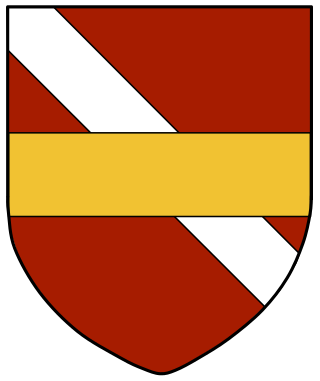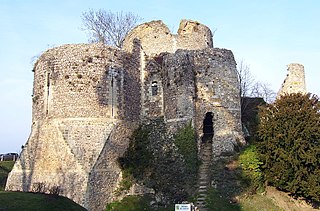Related Research Articles

William the Conqueror, sometimes called William the Bastard, was the first Norman king of England, reigning from 1066 until his death. A descendant of Rollo, he was Duke of Normandy from 1035 onward. By 1060, following a long struggle to establish his throne, his hold on Normandy was secure. In 1066, following the death of Edward the Confessor, William invaded England, leading an army of Normans to victory over the Anglo-Saxon forces of Harold Godwinson at the Battle of Hastings, and suppressed subsequent English revolts in what has become known as the Norman Conquest. The rest of his life was marked by struggles to consolidate his hold over England and his continental lands, and by difficulties with his eldest son, Robert Curthose.

Odo of Bayeux was Bishop of Bayeux in Normandy, and was also made Earl of Kent in England following the Norman Conquest. He was the maternal half-brother of duke, and later king, William the Conqueror, and was, for a time, William's primary administrator in the Kingdom of England.
Roger Bigod was a Norman knight who travelled to England in the Norman Conquest. He held great power in East Anglia, and five of his descendants were earls of Norfolk. He was also known as Roger Bigot, appearing as such as a witness to the Charter of Liberties of Henry I of England.

Robert, Count of Mortain, first Earl of Cornwall of 2nd creation was a Norman nobleman and the half-brother of King William the Conqueror. He was one of the very few proven companions of William the Conqueror at the Battle of Hastings and as recorded in the Domesday Book of 1086 was one of the greatest landholders in his half-brother's new Kingdom of England.
Hugh de Grandmesnil, , is one of the proven companions of William the Conqueror known to have fought at the Battle of Hastings in 1066. Subsequently, he became a great landowner in England.

William FitzOsbern, 1st Earl of Hereford, Lord of Breteuil, was a relative and close counsellor of William the Conqueror and one of the great magnates of early Norman England. FitzOsbern was created Earl of Hereford in 1067, one of the first peerage titles in the English peerage. He is one of the very few proven companions of William the Conqueror known to have fought at the Battle of Hastings in 1066. His chief residence was Carisbrooke Castle on the Isle of Wight, one of many castles he built in England.
The Revolt of the Earls in 1075 was a rebellion of three earls against William I of England. It was the last serious act of resistance against William in the Norman Conquest.
Robert de Beaumont, 1st Earl of Leicester, Count of Meulan, also known as Robert of Meulan, was a powerful Norman nobleman, one of the very few proven Companions of William the Conqueror during the Norman Conquest of England in 1066, and was revered as one of the wisest men of his age. Chroniclers spoke highly of his eloquence and his learning, and three kings of England valued his counsel. He was granted immense land-holdings in England by William the Conqueror and by Henry I and was created Earl of Leicester.

Roger de Beaumont, feudal lord of Beaumont-le-Roger and of Pont-Audemer in Normandy, was a powerful Norman nobleman and close advisor to William the Conqueror.

William the Conqueror had men of diverse standing and origins under his command at the Battle of Hastings in 1066. With these and other men he went on in the five succeeding years to conduct the Harrying of the North and complete the Norman conquest of England.
Raoul II de Tosny, lord of Conches-en-Ouche, was a Norman nobleman of the House of Tosny, son of Roger I of Tosny and older brother of Robert de Stafford / Tosny. He was active in Normandy, England and Wales.

Roger I of Tosny or Roger of Hispania was a Norman nobleman of the House of Tosny who took part in the Reconquista of Iberia.

The House of Tosny was an important noble family in 10th and 11th century Normandy, though it did not include any comtes or vicomtes. Its founder was Raoul I of Tosny.
Raoul III of Tosny (1079-1126), Lord of Conches-en-Ouche, was an Anglo-Norman nobleman of the House of Tosny.

St William of Breteuil or William de Breteuil was a Norman abbot and magnate who held extensive lands in central Normandy as the lord of Breteuil at the end of the reign of King William I and during the chaotic period afterwards when William's eldest son Robert Curthose, duke of Normandy, contested with his younger brother William Rufus, king of England. Upon the death of William Rufus while hunting in the New Forest, Lord William attempted—but failed—to block Prince Henry seizing the crown jewels from the Winchester treasury and declaring himself king in preference to the crusading Robert. Lord William was later abducted and tortured by a French noble who wanted to marry his illegitimate daughter Isabel. He is venerated as a saint in the Roman Catholic Church.
Roger I of Mortemer, founded the abbey of St. Victor en Caux in the Pays de Caux of Upper Normandy as early as 1074 CE. Roger claimed the castle of Wigmore, Herefordshire that was built by William FitzOsbern, 1st Earl of Hereford. This castle became the chief barony of Roger's descendants. He was the first Norman ancestor to assume the name Mortimer, as in the place-name Mortemer-en-Brai, the land on which the village and castle was located.
William of Évreux or William d'Évreux was a member of the House of Normandy who played an influential role during the Norman conquest of England, one of the few Norman aristocrats documented to have been with William I at Hastings. He was the count of Évreux in Normandy as well as additional lands and expanded his holdings by consenting to the marriage of his young ward and niece Bertrade to Fulk the Rude of Anjou, whose support against the Manceaux rebels was important for William's liege Robert Curthose. A feud between William's wife Helvise or Heloise of Nevers and Isabel of Conches, the wife of Raoul II of Tosny, led to open war between the two men. Helvise also governed Évreux in William's infirm old age until her own death. Having no children of his own, William was succeeded at Évreux by his sister's son Amaury of Montfort.
Hugh de Montfort (Hugh II) (died 1088 or after) was a Norman nobleman. He was Lord of Montfort-sur-Risle, Constable of Normandy and a companion of William the Conqueror. Hugh's father was killed in combat with Valkelin de Ferrières in 1045.

de Montgomerie (Montgomery) is a prominent family of Anglo-Norman origin, belonging to both French and British nobility. At the turn of the 12th century, the family was one of the leading families, with Robert de Bellême being the wealthiest and most powerful magnate in England and Normandy. The House was succeeded by the House of Belleme.

The Domesday Book of 1086 AD lists King William the Conqueror's tenants-in-chief in Snotinghscire (Nottinghamshire), following the Norman Conquest of England:
References
- ↑ Freeman, Edward A. (2011). The Norman Council and the Assembly of Lillebonne.